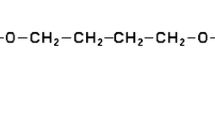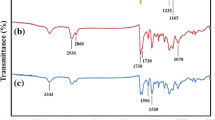Abstract
Various diphenylmethane diisocyanate-containing polyurethanes whose soft blocks differ in polarity and crystallizability have been investigated using deformation and scanning calorimetry to ascertain the contribution of different types of intermolecular interaction to elasticity of polyurethane elastomers.
The phase composition of polyurethanes being investigated and its dependence on mechanical action have been analyzed on the basis of scanning calorimetry data. By measuring the mechanical work and thermal effect during extension (λ=1–3.5) deformation dependences of internal energy changes and the ratio of energy and entropy changes have been determined as well as energy contributions have been calculated. The data obtained for different temperatures demonstrate that a decrease in the fraction of energy changes is largely due to hard block structurization in the course of re-building the network of hydrogen bonds during deformation.
Similar content being viewed by others
References
Noshay, A., I. E. McGrath, “Block copolymers”, New York, Academic Press (1977).
Estes, G. M., S. L. Cooper, A. V. Tobolsky, J. Macromol. Sci. Rev. Macromol. Chem.C(2), 313 (1970).
Lipatov, Yu. S., Yu. Yu. Kercha, L. M. Sergeeva, “Structure and properties of polyurethanes”, Naukova Dumka, Kiev, 279 (1970).
Bonart, R., L. Morbitzer, Kolloid. Z.232, 764 (1969).
Allport, D. C., W. H. Janes, “Block copolymers”, London, Applied Science Publ. Ltd., 620 (1973).
Paul, R., S. Newman, “Polymer Blends”, v. I, II, Academic Press, New York (1978).
Kwei, T. K., G. D. Patterson, T. T. Wang, Macromol.9, 780 (1976).
Godovsky, Yu. K., Colloid and Polymer Sci.260, 461 (1982).
Treloar, L. R., “The Physics of Rubber Elasticity” Clarendon Press (Oxford, 1975).
Mark, J. E., Rubber Chem. and Technology46, 593 (1973).
Godovsky, Yu. K., Polymer22, 75 (1981).
Wilkes, G. L., R. Wildnauer, J. Appl. Phys.46, 4148 (1975).
Shen, M., M. Groucher, J. Macromol. Sci. Rev. Macromol. Chem.C12, 287 (1975).
Tarasov, S. G., Yu. K. Godovsky, Polymer Science USSR22, 2061 (1980).
Sergeeva, L. M., Yu. S. Lipatov, O. V. Sereda, in: “Synthesis and physicochemical properties of polymers (polyurethanes)”, issue 7, Kiev, Naukova Dumka, 187 (1970).
Author information
Authors and Affiliations
Rights and permissions
About this article
Cite this article
Godovsky, Y.K., Bessonova, N.P. Thermoelasticity of segmented polyurethanes. Colloid & Polymer Sci 261, 645–651 (1983). https://doi.org/10.1007/BF01415034
Received:
Accepted:
Issue Date:
DOI: https://doi.org/10.1007/BF01415034




